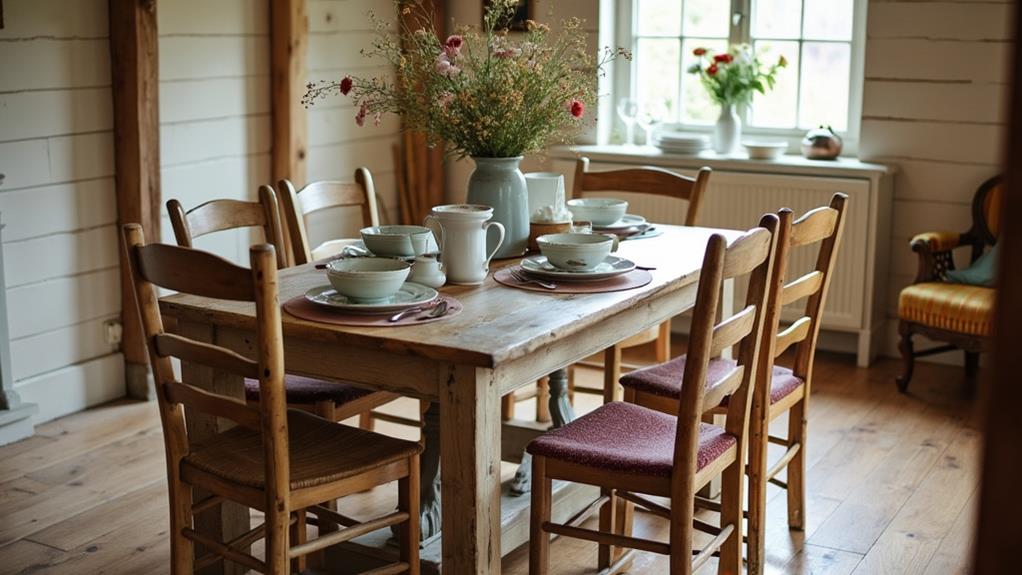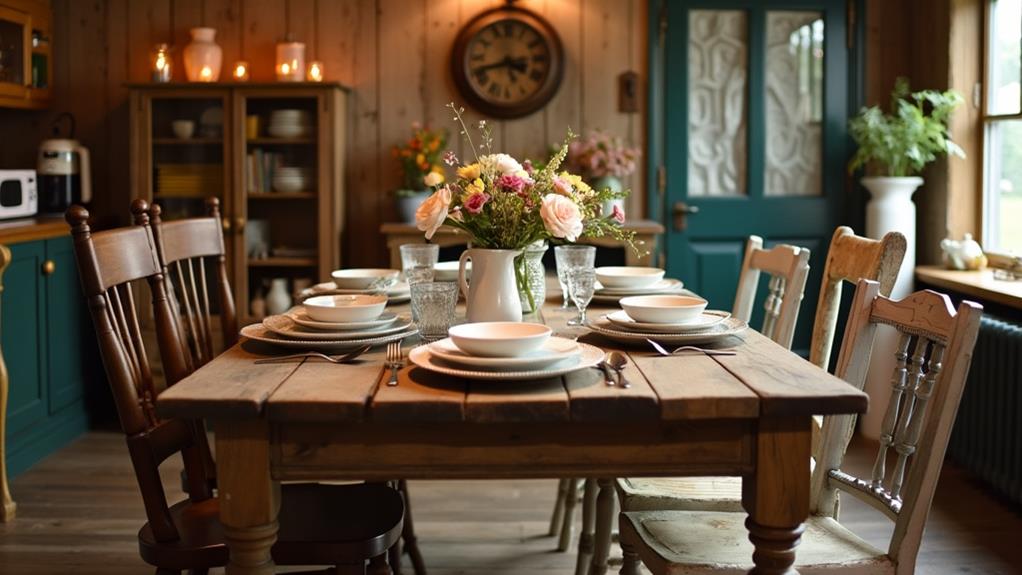Selecting the perfect farmhouse dining table involves balancing rustic aesthetics with practical considerations. We should prioritize natural materials like wood or stone for a warm ambiance, ensuring the table's size fits comfortably in the dining area with at least 36 inches of clearance. It's important to account for each diner needing about 24 inches of space and align the table height with standard chair heights. Rectangular tables work well for large gatherings, while round tables foster intimacy. Finally, material and finish choices should reflect our lifestyle and existing decor, with durability and maintenance factors in mind. For further insights, we'll explore additional significant aspects ahead.
Understanding the Farmhouse Style

When it comes to understanding the farmhouse style, we first need to appreciate its roots in rural, rustic aesthetics. The farmhouse style draws its inspiration from the simplicity and functionality of country living, where practicality and comfort are paramount.
This style often incorporates natural materials such as wood and stone, aiming to create a warm, welcoming environment that feels both lived-in and timeless. For instance, solid wood dining room pieces from Artisan Furniture perfectly embody these characteristics with their stain finishes and impeccable craftsmanship.
In farmhouse dining tables, we see an emphasis on sturdy construction and straightforward design. These tables are typically crafted from solid wood, showcasing knots and grain patterns that highlight the material's natural beauty. The finish is often distressed or weathered, adding to the table's rustic charm.
Proportionally, farmhouse tables tend to be substantial, providing a sense of permanence and durability that echoes the lasting quality of traditional farm life.
Additionally, the farmhouse style embraces a sense of community and togetherness. Large, rectangular tables are common, accommodating family gatherings and fostering social interaction.
The design invites us to gather, share meals, and create memories, reinforcing the farmhouse ethos of connection and warmth. By understanding these elements, we can better appreciate the farmhouse dining table's role in creating an inviting and functional dining space.
Measuring Your Dining Area
As we embrace the inviting charm of farmhouse dining tables, it's important to guarantee they fit seamlessly into our dining space. To achieve this, we must first accurately measure our dining area. This confirms that our chosen table not only complements the room aesthetically but also allows for comfortable movement and functionality.
Begin by measuring the length and width of the dining room. Use a tape measure to get precise dimensions, noting any architectural features such as windows, doors, or built-in cabinetry that might affect placement. It's essential to leave adequate space around the table for chairs and for people to move comfortably. A general rule is to allow at least 36 inches between the table edge and the walls or other furniture.
Next, consider the height of the table in relation to the height of the room and any existing fixtures, such as lighting. Confirming proper clearance helps maintain a balanced and proportional look.
Additionally, take into account the size and placement of any rugs, as they can impact both the visual and physical space around the table.
Identifying the Ideal Size

Choosing the perfect dining table size hinges on a few key factors that guarantee both comfort and practicality. First, we must consider the dimensions of our dining area to make sure the table fits comfortably, leaving ample space for movement and additional furniture.
A good rule of thumb is to allow at least three feet of clearance around the table's perimeter. This space guarantees easy navigation and avoids a cramped environment. Additionally, it's beneficial to select tables with solid wood construction to guarantee durability.
Next, we need to think about seating capacity. Typically, each diner requires approximately 24 inches of table length for a comfortable dining experience. For instance, a six-foot table can accommodate six to eight people, depending on the chair width and table shape.
Additionally, the width of the table plays a vital role in functionality. A standard width of 36 to 42 inches allows for sufficient space for place settings and serving dishes without overcrowding.
Lastly, the height of our farmhouse dining table should align with standard dining chair heights, which are typically around 18 inches. A table height between 28 to 30 inches usually works well, providing an ideal balance for legroom and overall dining comfort.
Choosing the Right Shape
Selecting the right shape for our dining table is essential for enhancing both the aesthetics and functionality of our dining area. The shape of our table notably impacts the room's flow and how we interact during meals.
Rectangular tables are the most common and versatile, ideal for larger spaces as they can accommodate more people and provide ample surface area for dishes and decorations. They also align well with most room layouts, offering a balanced and organized appearance.
Square tables, on the other hand, are perfect for smaller spaces or square-shaped rooms. They promote a more intimate dining experience, with everyone seated at equal distances. This shape works well for casual gatherings and can easily be expanded with leaves for additional seating when necessary.
Round tables foster a sense of equality and conversation, making them great for social dining. They fit well in smaller spaces and can create a cozy, welcoming atmosphere. However, they may not be as efficient for seating large groups unless they're notably oversized.
Oval tables combine the best of rectangular and round tables, offering the elongated surface of a rectangle with the softer edges of a round table, making them versatile and aesthetically pleasing.
Selecting the Perfect Material

Now that we've explored the importance of table shapes, let's focus on selecting the perfect material for our dining table. The material we choose will greatly impact the table's durability, maintenance, and aesthetic appeal.
Wood is a classic choice, offering a warm, inviting look. Hardwoods like oak, maple, and walnut are particularly durable and can withstand daily wear and tear. These woods also develop a beautiful patina over time, adding character to our dining space.
For those seeking a more rustic feel, reclaimed wood is an excellent option. It not only promotes sustainability but also brings a unique history and charm to our table.
On the other hand, if we prefer a sleek, modern look, metal or glass might be more suitable. Metal tables, made from materials like steel or iron, provide a sturdy, industrial vibe, while glass tops offer a light, airy feel, making our dining area appear more spacious.
Additionally, stone materials such as marble or granite can create a luxurious, sophisticated atmosphere. However, they require careful maintenance to avoid staining or etching.
Ultimately, considering our lifestyle and aesthetic preferences will guide us in selecting the ideal material for our farmhouse dining table.
Deciding on Color and Finish
When it comes to deciding on the color and finish of our dining table, a few key factors can make all the difference. First, we should consider the existing color palette of our dining space. A harmonious color scheme ties the room together, so selecting a table finish that complements or contrasts strategically with our walls, flooring, and décor is vital.
Neutral finishes, like natural wood tones or white, offer versatility and timeless appeal, while bold colors can serve as striking focal points.
Next, we need to think about the mood we want to create. Darker finishes, such as espresso or black, often convey a sense of elegance and formality, whereas lighter finishes, like oak or pine, evoke a more casual and airy atmosphere.
Additionally, the type of finish—whether matte, glossy, or distressed—plays a significant role in the table's overall aesthetic. A matte finish provides a subtle, understated look, whereas a glossy finish can add a touch of sophistication and make the table stand out.
Lastly, we should evaluate the maintenance requirements of different finishes. Some finishes, like high gloss, may show scratches and fingerprints more readily, necessitating frequent cleaning, while others may be more forgiving and easier to maintain.
Considering the Table's Functionality

While the color and finish of our dining table play a significant role in the room's aesthetics, we can't overlook the table's functionality. To guarantee our farmhouse dining table meets all our needs, we must consider its size, shape, and extendability. These factors are vital for accommodating family gatherings, dinner parties, and daily meals.
Table of Functional Considerations
| Factor | Description | Considerations |
|---|---|---|
| Size | The table's dimensions in length and width | Room size, number of people it can seat |
| Shape | The geometric form of the table | Room layout, style preference, space efficiency |
| Extendability | The ability to expand the table for more seating | Ease of use, storage for extension leaves |
First, the size of our table should align with the room's dimensions and the number of people we plan to seat regularly. A too-small table might make gatherings uncomfortable, while a too-large table could overwhelm the space.
Next, the shape of the table—whether rectangular, square, round, or oval—affects not only the room's flow but also the table's seating capacity and interaction dynamics.
Lastly, extendability is essential for those of us who host varying numbers of guests. Tables with extension leaves provide flexibility, allowing us to adapt to different occasions seamlessly. By considering these functional aspects, we can guarantee our dining table is not only beautiful but also practical and versatile.
Determining the Price Range
Determining the price range for our dining table is vital to guarantee we make an informed decision that fits our budget. First, we should set a clear budget ceiling before browsing options, as this helps us avoid the temptation of splurging on upscale models that may strain our finances.
We must consider both the initial cost of the table and any additional expenses, such as delivery fees, taxes, and assembly costs. By understanding the expected annual growth rate in the market, we can better gauge the value of our investment.
Next, evaluating the quality of materials and craftsmanship is essential, as these factors greatly influence price. Solid wood tables, for instance, tend to be more expensive than those made from engineered wood or veneer.
We should also account for the table's size and design complexity, which can drive up costs. Custom-made tables or those featuring intricate details often come with a higher price tag.
Moreover, we should explore various purchasing avenues, such as local furniture stores, online retailers, and second-hand options. Comparing prices across these sources allows us to identify the best deals.
Taking advantage of seasonal sales or bulk discounts can further stretch our budget. By diligently reviewing these aspects, we guarantee our chosen farmhouse dining table aligns with both our financial constraints and aesthetic preferences.
Final Tips for Selection

After setting a clear budget and understanding the financial aspects, let's focus on the final tips for selecting the perfect dining table.
First, we should consider the table's dimensions. Measure your dining space accurately, ensuring there's enough room for chairs to be pushed back comfortably and for people to walk around. A general rule is to allow at least 36 inches between the table edge and the wall or other furniture.
Next, let's think about the table's shape. Rectangular tables are versatile and often suitable for larger gatherings, while round tables can create a more intimate setting and fit well in smaller spaces. Consider your typical dining habits and the number of people you usually entertain.
Material choice is also essential. Solid wood tables offer durability and a timeless aesthetic, but they may require more maintenance.
Veneer and laminate options can be more affordable and easier to clean, though they mightn't last as long.

